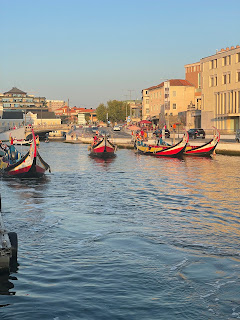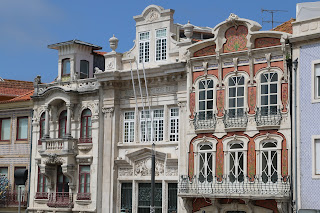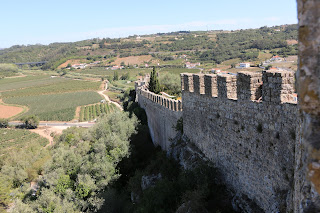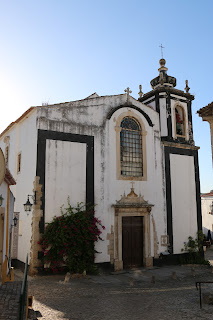The transfer to Aveiro (back via Porto) was seemless and up to the very good standard of public transport in general. It was a short walk to our accommodation via the usual cobbled roads. Nothing to do today, other than get to the supermarket and go for a wander later in the evening to check out the old part of town (and the biggest jigsaw puzzle ever whilst new roading is being laid).
Aveiro is sometimes known as the Venice of Portugal (although not if you've actually been to Venice!). The old town has canals running through it, lots of bridges and art nouveau style beautiful buildings. The 'famous' bridge(s) are covered in lovers ribbons (a bit like the Paris locks). Aveiro used to be a sea port town, until a storm removed their sea access in 1575 and created the landscape we see today.
After an early morning run, that gave us great views of the salt pans and Flamingos, we headed to the info centre to get a map of town, and started exploring. Regardless of the specific sites, the town is quaint with lovely small lanes tucked away in all directions, with great squares and meeting places, and even an inner city 'pay as you go' beach!
We did pass Igreja de Sao Goncalinho (Church of Sao Goncalinho), and then found the 1904 Mercado do Peixe (fish market). It's now an upmarket food court, still retaining the 1875 fountain out the front.
We walked the old centre for a bit, taking photos of the canals and bridges, then headed out to do the 4km circuit of the salt pans and wildlife. It's getting pretty hot now and from the mounds of salt everywhere, the poor workers have been shoveling all morning!
The afternoon consisted of people watching in the square, by the fish market, before heading indoors for a break. We were back out again in the evening and before dinner jumped on a Moliceiro boat. The canal cruise lasted around 35 minutes and is something pretty much everyone does here. Lovely day.
The next adventure was to head to Costa Nova. We took the more scenic bus (not direct), to see a bit more of the region including the port, Barra and Barra’s impressive 1893 lighthouse (one of the ten highest lighthouses in the world). It's the tallest in Portugal and it’s light is 60 metres above sea level.
Costa Nova is a peninsular with a lagoon on one side and the Atlantic Ocean on the other. We visited the very active fish market on the lagoon side, with all its 'interesting' sights and smells, before venturing off.
The Atlantic Ocean side has great boardwalks, to protect the dunes, and we spent some time walking Praia Da Costa Nova towards Praia Da Barra. Views aplenty, we stopped at a sand bar for a beer and to watch the beach goers. The famous lighthouse, from Costa Nova, looks miniscule.
Costa Nova is also famous for its stripey painted houses. Now a tourist attraction, but actually something that was borne from previous eras' fisherman, coating their homes with fish oil, to protect the timber. We found one of the originals, a refurbished 1893 home, in this style of colouring. Originally only the natural colours of black and deep red were used, but now it’s all bright pastels. There were many cute painted houses, and Budget got in on the action.
After trying the local sweet, Tripa (a crepe style dessert, but not our thing), we had time to relax by the canal, before our bus back, and take in the view across the water, also seeing the farmed seaweed beds emerging from the low tide.
Back in Aveiro, in the evening whist searching for dinner, we happened across the picturesque, early 17th century Igreja Ja De Nossa Senhora Da Apresentaco (church of our Lady of the Presentation), with its beautiful blue and white tiled panels. On the dinner front, and now two failed attempts, it's fair to say the Portugese do not do Italian food well!
Our final day in Aveiro we decided to do the Lonely Planet art nouveau walking tour (ironic as you would normally do this first), to check out some of the iconic buildings. First up was Hotel Americas and many other unmarked, yet attractive or unusual, others. The 1858 Rua Do Carmo Palace, had really different and cool raised blue and white tiles.
A bit further on was Casa da Silva Rocha, then we passed the Mercado do Peixe (fish market), which we had seen previously.
The castle dates back to Roman occupation (8th century), but the current layout is Moorish and the result of restorations and reconstructions (different Portugese Kings), starting in 1148. It is simply an iconic landmark you can't miss as you approach.
We headed outside of the Castle walls and down to the large imposing 1747 Baroque church (Our Lord Jesus of the Stone Sanctuary). We carried on out of town to get the city view from across the valley, before stopping for lunch.
After some admin and planning it was time to head back out. We had a fabulous dinner and stopped on the way home to try the cherry liqueur in a chocolate cup, something Obidos is known for. It was delicious!
The next day we were up early to check out the old town before the crowds arrived. It was a lovely morning retracing our steps from our previous visits, and managing to get the photos we wanted, people free. Just after 9am the tour buses started to arrive and the town is once again awoken. Definitely quieter on week days though.
Some of the amazing sites we captured included the 1380 city gate and the Oratory of our Lady of Piety, and then we went up again, briefly, onto the city walls to take the high shots of the entire old town looking towards the castle.
From there it was a nice slow walk up the 13/14th century Rua Direita (main street), how amazing it was almost entirely people free.
Then onto the low street we viewed the Gothic Tomb Chapel (St Martins Chapel, 1331). This building is one of the oldest remaining medieval buildings in Obidos and has ancient tombs, including one of a knight. Opposite it, is the 14 century St Peter’s church (although now mostly rebuilt after the 1755 earthquake).
Back at the main square and the imposing St Mary’s Church. To the left is the Town Portico (former market place - the vernadah dates back to the 11th century), to the right is the 18th century Manor House, and in front is the 1513 Pillory (a stone column used for punishment or humiliation). Directly below that is the St Mary fountain (likely, as with most fountains here, the historic towns water source).
We carried on up towards the Castle. The 12th century St James Church sits alongside it with commanding views over the town, mostly rebuilt after the earthquake.
At the foot of the Castle, we got great views of the ancient city's towers, and back down over the old town. We climbed the rocky steps to the top of the city walls and got sensational views in the early morning light, including great shots of the 16th century Aqueduct.
Back on the low road we passed the 12/13th century Valley Gate (Lady of Grace gate) and passed through the beautiful Arch connected to the 16th century old Townhall, Court and Prison. From here we looped back to the 16th century Almshouse Church and the split cobbled street and arch. Sounds like we've walked for miles but the town is super compact, so very easy to cover lots of ground.
Before heading back out the gates we stopped for amazing waffles for breakfast, and then checked off the final two points of interest. These being the 15th century Memorial Cross that celebrates victory over the Moors, and the 14th century St John the Baptist church (and cemetery) that we had originally seen from high up on the city walls.
The afternoon visit included the Queens Square / Old Arms Square to see the actual 'Castle' itself and the official grounds. It's the only part of the town a fee is required for entry. This is where you get to see the castle as you would expect it to look and it was pretty special. The cherry on top of the whole town that is Obidos.
We took some time to absorb our visit here, it's been a very special place and we are so glad we decided to spend a few days (rather than the day trip most do). Popping in and out of the city walls as we wanted was really cool. Couldn't resist finishing the day with No.7 Cherry liqueur in a chocolate cup!




























































































































No comments:
Post a Comment